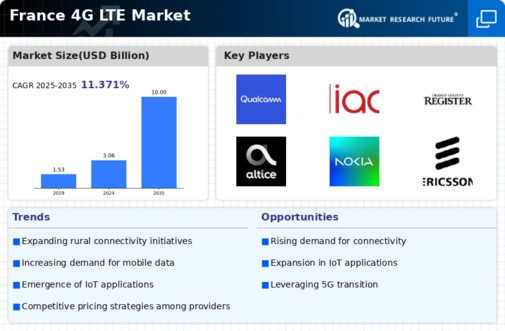Emergence of IoT Applications
The rise of Internet of Things (IoT) applications is significantly influencing the 4g lte market in France. As of November 2025, the number of connected IoT devices in the country is projected to exceed 50 million, creating a substantial demand for reliable mobile connectivity. The 4g lte market is poised to benefit from this trend, as IoT applications require consistent and high-speed data transmission for effective operation. Industries such as agriculture, healthcare, and smart cities are increasingly adopting IoT solutions, which rely on robust mobile networks. This growing reliance on IoT technology is likely to drive investments in 4g lte infrastructure, as service providers seek to enhance their capabilities to support a diverse range of applications and devices.
Rising Smartphone Penetration
The proliferation of smartphones in France is a pivotal driver for the 4g lte market. As of November 2025, smartphone penetration in the country has reached approximately 85%, indicating a substantial increase in mobile device usage. This trend suggests that more consumers are accessing mobile data services, thereby fueling demand for faster and more reliable connectivity. The 4g lte market is likely to benefit from this surge, as users increasingly rely on mobile applications, streaming services, and social media platforms. Furthermore, the growing preference for high-definition content and real-time communication applications necessitates robust network capabilities, which 4g lte technology can provide. Consequently, the rising smartphone penetration is expected to drive investments in network infrastructure and service enhancements, ultimately contributing to the growth of the 4g lte market.
Increased Focus on Mobile Broadband
The shift towards mobile broadband services is a notable driver for the 4g lte market in France. Consumers are increasingly favoring mobile broadband over traditional fixed-line services due to its flexibility and convenience. As of November 2025, mobile broadband subscriptions have surged, accounting for over 60% of total broadband connections in the country. This trend indicates a growing preference for on-the-go connectivity, which the 4g lte market is well-positioned to fulfill. Service providers are likely to respond by enhancing their 4g lte offerings, ensuring that users experience high-speed internet access regardless of their location. Consequently, the increased focus on mobile broadband is expected to stimulate competition among providers, leading to improved service quality and customer satisfaction.
Government Initiatives and Regulations
Government policies and regulations play a crucial role in shaping the 4g lte market in France. The French government has implemented various initiatives aimed at promoting digital connectivity and enhancing mobile network infrastructure. For instance, the national strategy for digital development emphasizes the importance of expanding 4g lte coverage to rural and underserved areas. This initiative is expected to increase accessibility and stimulate competition among service providers. Additionally, regulatory frameworks that encourage investment in telecommunications infrastructure are likely to foster innovation within the 4g lte market. As a result, these government initiatives may lead to improved service quality and increased consumer adoption of mobile data services, further propelling the growth of the market.
Adoption of Advanced Mobile Technologies
The ongoing adoption of advanced mobile technologies is a significant driver for the 4g lte market in France. As consumers demand faster and more reliable internet services, telecommunications companies are investing in upgrading their networks to support advanced features such as Voice over LTE (VoLTE) and enhanced data speeds. By November 2025, it is anticipated that a substantial portion of mobile users will utilize these advanced services, further propelling the growth of the 4g lte market. This trend suggests that service providers must continuously innovate and enhance their offerings to meet consumer expectations. Additionally, the integration of advanced technologies may lead to improved operational efficiencies and cost reductions for providers, ultimately benefiting the overall market landscape.



















Leave a Comment